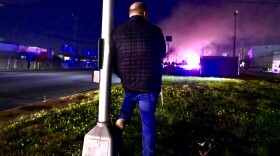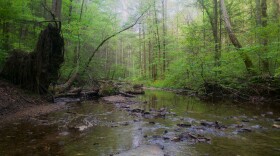A local art teacher, a ceramicist and an alumni from the Kentucky School for the Blind have dedicated countless hours over the last five years creating an art project on a bustling block of Frankfort Avenue in Clifton.
The 57-foot-long curved structure sits inside Bank Commons, a small park catty-corner to the American Printing House for the Blind.
Its placement is intentional, said muralist and art teacher Liz Richter. While the wall is a colorful display for sighted people, the materials that make up the wall allow the blind and low-vision community to feel the artistic images that convey Clifton history.
The 400-square-foot art installation is a true multi-sensory display, and the creatives behind it have dubbed it “a passion project” and an inclusive display for all residents. Clifton is home to a significant population of blind and low-vision residents due to the American Printing House for the Blind and Kentucky School for the Blind being located in the neighborhood.
Every color, every tile
Richter has taught art at Kentucky School for the Blind for the last 15 years. She has also created several murals around Louisville, and when she discussed her work with her students, there was a disconnect.
“How would that apply to them if they weren't going to these places and experiencing something 2D?” Richter said. “It just sort of made me realize what I'm doing on the streets at that point was not accessible to them.”
Thus, the idea for the public art installation was born. Richter, a longtime Clifton resident, wanted to build something for her blind and low-vision neighbors. Ceramicist and fellow resident Kristen Falkirk heard Richter’s idea five years ago at a mural workshop.
“I don't care what I have to do, I just want to be a part of it,” Falkirk said. “We started talking, and then we combined forces, and now this beautiful piece exists from both of us, and to me it's like our love letter to Clifton, because we both love this neighborhood so much.”
At the time, Darren Harbour lived in the apartment building next to where the art installation would be built. He joined Richter and Falkirk on the project as the disability inclusion specialist and a fellow artist.
Harbour developed retinitis pigmentosa, a rare eye disease that slowly breaks down one’s vision, as a teenager. Now, he’s a graduate of the Kentucky School for the Blind and disability advocate.
“I lost my sight gradually,” Harbour said. “So I understand, also, from a low-vision aspect to a no-vision aspect. There's a way to embody perception and bring it to life.”
The ceramic tiles that form the art installation are small enough so Harbour and other blind residents can tactilely feel what is on the wall.
“I could feel the different flowers and their petals and the way that the leaves opened up at the bottom, and the strong stem,” Harbour explained while touching the tiles. “And then out of the flower comes the base of a building that might be the Kentucky School for the Blind, that might be the Silver Dollar, or the American Printing House. Now you transition over to a railroad track and somebody walking their dog, and there's just these pieces and these visual perceptions just brought to life.”

Falkirk and Richter hand cut, carved, finished and glazed every tile.
“You'll never find two pieces that look exactly the same,” Falkirk said. “We think that each tile has been touched about 14 times between the very original rolling out of the clay, because we work from clay slabs until packaging up to bring it here. We've been actively carving tiles for about three years.”
Some pieces have finer ridges and grooves on buildings, walkways, vehicles and people that Harbour can feel on the structure. Harbour is also depicted walking on the street at the bottom of the wall.
“Even the tiniest of details are more tactile,” Harbour said. “On my particular ceramic tile, you could feel my full beard, but you can feel the difference in the texture of my beard versus the jacket, versus my fringes [on my shirt] versus the cane.”

Harbour worked with Richter and Falkirk to find colors most visible to the low-vision community, or people that have some of their sight. Harbour said high-contrast colors work best.
“With retinitis pigmentosa, the reverse contrast tends to be what helps visuals to pop out the most,” he said. “So white on black or light colors on dark colors help it to pop out more, as opposed to dark colors on a bright background. The brightness in the background could actually drown out the colors on the surface.”
The tiles are cemented with a chocolate-colored grout to allow the bright pinks, blues, yellows and reds to stand out more. Richter and Falkirk mixed and placed the grout themselves and used some unconventional tools to keep it in place.

“We found we needed carving tools,” Falkirk said. “So I found that crab forks [used to extract meat out of a crab’s shell] work really well.”
Access for all
Falkirk and Richter said they had to navigate many challenges bringing the project to life, including their own perceptions of the blind community.
“An accidental surprise as we've gone through this process is learning that—in terms of multisensory [experiences] —the application for this is so much more broad than we were originally thinking,” Richter said. “There are so many sensory-seeking individuals, whether it's the autism community or other people who enjoy art for more than one sensory input, and that's been something really lovely to understand that we didn't know we were creating something that crosses different barriers.”
The project was created in partnership with Louisville Visual Arts (LVA) and the Kentucky School for the Blind Charitable Foundation.
Angela Hagan is LVA’s executive director.
“Art is just one part of that coming together cross sectorally to help communities be healthy and thrive,” she said. “Why can't we offer more opportunities for people to use other senses to engage in art?”
A dedication event will open the project to the public on Oct. 10. There will also be a QR code near the structure to scan and listen to Harbour describe what is on the wall.
“We are inviting the community to celebrate with us, not only the blind and low-vision impairment community from the neighborhood, but the Clifton neighborhood residents, our broader community,” Hagan said. “'I’m hoping that other neighborhoods hear about this and will be inspired to say, ‘How we could do something like this in our neighborhood?’”







